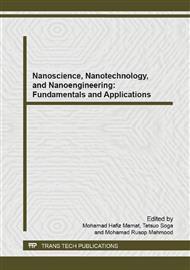p.419
p.424
p.429
p.434
p.439
p.444
p.448
p.451
p.456
Gold Nanoparticles - An Enhanced DNA Sensing Tools Using Surface Enhance Raman Scattering
Abstract:
Molecular recognition of specific DNA target is crucial for species authentication, drug discovery, forensic investigation and biodiagnostics. Development of nanoparticles at atomic scale and molecular level offers remarkable biocompatibility in the detection of DNA hybridization. Oligo-functionalized nanoparticles with controlled sizes and shapes have come forward with advantages over the previously documented DNA detection assays. Nanomaterials facilitate signal transduction and synergism in biomolecular interaction, promoting both conventional and newly developed DNA identification platforms. Tailoring of DNA sensing tools with gold nanoparticles (Au NPs) enhances the Surface Enhanced Raman Scattering (SERS) signal, allowing target detection with molecular precision. Here we briefly reviewed the recent AuNPs based SERS-platforms for the specific, sensitive and reliable detection of DNA targets for species authentication in foods and feeds.
Info:
Periodical:
Pages:
439-443
Citation:
Online since:
June 2015
Authors:
Price:
Сopyright:
© 2015 Trans Tech Publications Ltd. All Rights Reserved
Share:
Citation:


